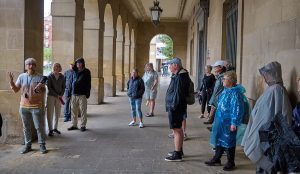We began our day by learning that one member of our group had hurt her ankle while walking in the cobblestone streets. Fortunately, her ankle was not broken. Then we began walking in the rain.
 We met Leo, our tour guide for the city of Pamplona. He made a good impression by taking us to a cafe that enabled us to take shelter from the rain and to warm up with coffee, tea or hot chocolate, with Spanish cookies that are known in New York as Italian cookies.
We met Leo, our tour guide for the city of Pamplona. He made a good impression by taking us to a cafe that enabled us to take shelter from the rain and to warm up with coffee, tea or hot chocolate, with Spanish cookies that are known in New York as Italian cookies.
 Then
Then  we walked in the rain to the Cathedral (officially “Catedral Metropolitana de Santa María la Real de Pamplona), which has a neoclassic exterior and a gothic interior. We could have spent hours there. The tombs of King Charles III and his wife Queen Eleanor were in the center of the nave, done in alabaster, while the surrounding art is made of marble. At the foot of the queen’s tomb, there are two dogs fighting over a bone. The bone represents Pamplona. A lion representing his power is at the king’s feet.
we walked in the rain to the Cathedral (officially “Catedral Metropolitana de Santa María la Real de Pamplona), which has a neoclassic exterior and a gothic interior. We could have spent hours there. The tombs of King Charles III and his wife Queen Eleanor were in the center of the nave, done in alabaster, while the surrounding art is made of marble. At the foot of the queen’s tomb, there are two dogs fighting over a bone. The bone represents Pamplona. A lion representing his power is at the king’s feet.

There was a side entrance to the cathedral that was only available for entry by musicians. Many years ago, an American clarinet player was allowed to enter through that door. He was Woody Allen.

 There was so much to see inside the cathedral. There was a museum that housed many artifacts. We saw what was a spacious dining hall in which monks took their meals in silence. A kitchen is off that room. There was a room for Gregorian chants, an Archaeology Room, and a cloister. Nick was so taken by the many things to photograph that he became separated from the group. I was just about to bring this to Todd’s attention when Nick caught up with the rest of us.
There was so much to see inside the cathedral. There was a museum that housed many artifacts. We saw what was a spacious dining hall in which monks took their meals in silence. A kitchen is off that room. There was a room for Gregorian chants, an Archaeology Room, and a cloister. Nick was so taken by the many things to photograph that he became separated from the group. I was just about to bring this to Todd’s attention when Nick caught up with the rest of us.
There are tributes to Hemingway throughout Pamplona, as in this sculpture, because he put the city on the world map in his classic novel, The Sun Also Rises. Iruña is the Basque word for Pamplona.
Next we visited a private bullfight museum that was maintained by the widow of its creator. Many items relating to bullfighting were displayed. The proprietor, Mari Carmen, served us rosé wine and pintxos that she prepared: roasted peppers on toast and peppers stuffed with chorizo. We devoured them!
After that, Leo showed us the path on which the Running of the Bulls takes place each July. We learned that the white clothing that the runners wear represent purity, while their red scarves and sashes represent the blood of St. Fermín, the city’s patron saint.
There are private dining clubs clubs in Pamplona, at which only men are members who cook for each other and for guests. We were invited to such a club for the midday meal. Our hosts offered us drinks (sangria, cider, water, and white wine), and a pintxo (bread rubbed with garlic, sprinkled with olive oil, and topped with thinly sliced Roma tomatoes). There was a mushroom course, followed by a paella-like dish of mussels and calamari in vermicelli, because vermicelli takes less time to cook than rice. After that there were pork cheeks that were so tender that no knife was needed to cut them. Dessert was lemon sorbet.
At some point during the day, I told Todd that I had concerns about walking five miles on the Camino, because of my hip replacement. He said that the hills on the Camino were not nearly as steep as the ones we climbed to reach the citadel in Saint-Jean-Pied-de-Port. He told me that our bus would be available to any of our group members who might want to stop walking after forty-five minutes. The final decision would be mine.
14, 589 steps
